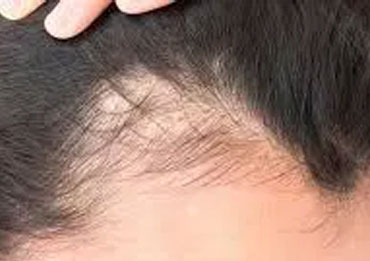Telogen Effluvium
Telogen effluvium is a scalp disorder characterized by the thinning or shedding of hair, resulting from the early entry of hair into the telogen phase (the resting phase of the hair follicle).
Telogen effluvium is a form of temporary hair loss that usually happens after stress, a shock, or a traumatic event. It usually occurs on the top of the scalp. It is different from the permanent hair loss disorder called alopecia areata. Large amounts of a person’s hair might fall out but it is often temporary and the hair usually grows back.
What causes Telogen effluvium?
A disturbance of the normal hair cycle increases hair shedding in telogen effluvium. Common triggers of telogen effluvium include childbirth, severe trauma or illness, a stressful or major life event (such as losing a loved one), marked weight loss and extreme dieting, a severe skin problem, a new medication, or withdrawal of hormone treatment. In around a third of people diagnosed with Telogen effluvium, no cause is found. Telogen effluvium is not inherited and it can affect all age groups and both genders equally.
Symptoms
The main symptom of telogen effluvium is an increase in the amount of hair a person sheds. Someone may notice that more hair than usual is falling out when they wash or brush their hair. They may also find more hair in the drain or on their pillow.
How is Telogen effluvium diagnosed?
The diagnosis is usually based on appearance and the history of the hair shedding. The hair may be gently pulled to see if an increased quantity of hair is shed (although this test may be falsely negative if the hair has been washed within 48 hours beforehand) and occasionally hairs are plucked from the scalp so that they can be examined under the microscope. Very rarely a skin biopsy may be required.
Treatment
Treatment for Telogen effluvium depends on what is triggering hair loss. Once the trigger has been established and addressed, the hair cycle should normalize and hair will begin to grow back.
Treatment options include:
- Addressing nutritional deficiencies through diet
- Platelet-Rich Plasma (PRP) proven method for regrowth
- Non-surgical hair replacement
- Hormone replacement therapy for people experiencing menopause
- Counseling support to manage stress or anxiety
A person should try to avoid chemical or heat treatments that could damage the hair. They should also avoid heat styling and heat treatment, such as curling or perming the hair.
Dietary considerations include the following:
- Protein provides the building blocks for hair to grow. The diet should include plenty of protein-rich foods such as meat, eggs, fish, beans, grains, and nuts. The amino acid lysine may be particularly important for hair growth.
- Iron deficiency may be linked to telogen effluvium so making changes to the diet to include iron-rich foods may help with hair loss. These include red meat, liver, dark green leafy vegetables, beans, and lentils.
- Supplementation can be considered for a short time whilst nutritional status is improved.
Regrowth
It is common for hair to grow back within 3 to 6 months after the trigger has been dealt with. Sometimes, the rate of shedding slows down but does not stop entirely. In most cases, no more than 50 percent of the hair is lost.
Written by Khuram Abbas Raja for The Regrow Hair Centre.
*Medical News Today
*British Association of Dermatologists










